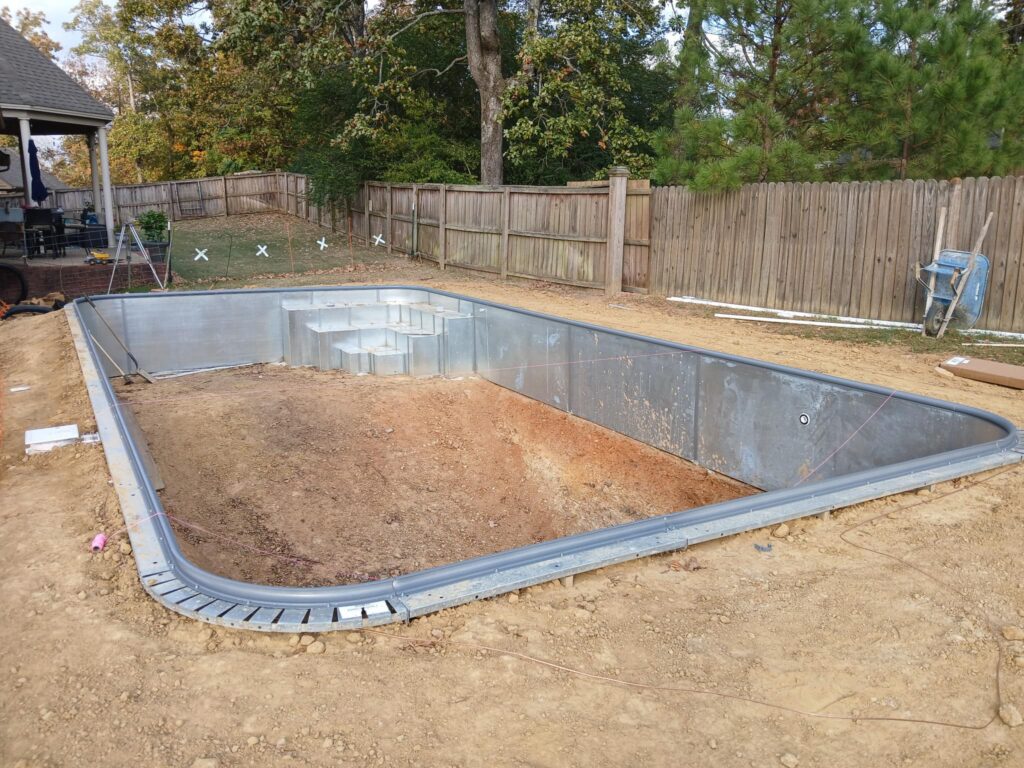To prepare your yard for pool installation in Arkansas, start by selecting a sunny, debris-free location that offers easy access for installation equipment.

Preparing your yard for this big project is essential for a smooth installation process. In Arkansas, where warm summers invite outdoor activities, having a pool can be a great addition to your home. However, getting your yard ready involves more than just digging a hole.
You need to consider the layout, drainage, and local regulations. Each of these factors plays a vital role in ensuring your pool is safe and enjoyable. This guide will help you understand the key steps to take before your pool installation begins. Let’s dive into how to prepare your yard for a successful pool project with Sea Turtle Pools.
Introduction To Pool Installation in Arkansas
Installing a pool in your yard can change your outdoor space. It creates a fun area for family and friends. Many people in Arkansas dream of having a pool. The warm weather makes it enjoyable to swim. Proper preparation is key to a successful pool installation.
Understanding the process helps you avoid surprises. Knowing what to expect makes planning easier. Let’s explore the appeal of a backyard pool and what to consider before installation.
The Appeal Of A Backyard Pool
A backyard pool offers fun and relaxation. It becomes a gathering place for family. Kids can play and enjoy the water. Adults can unwind and soak up the sun.
Backyard pools add value to your home. They create a beautiful outdoor space. Friends and family often visit for pool parties. This can strengthen bonds and create lasting memories.
Key Considerations Before Installation
Before installing a pool, think about your yard’s layout. Check your available space. Consider the size and shape of the pool. Make sure it fits your lifestyle.
Local regulations and permits are important. Each area has rules about pool installation. Check with local authorities to ensure compliance.
Think about safety features. Fencing and pool covers help keep children safe. Consider the maintenance needs of your new pool.
Lastly, budget for installation and ongoing costs. Factor in repairs, cleaning, and utilities. A clear plan helps avoid unexpected expenses.
Evaluating Your Yard Space
Preparing your yard for a pool installation is crucial. This step shapes your pool experience. Proper evaluation helps avoid future issues. Assessing size, location, soil, and terrain is key.
Assessing Size And Location
Start by measuring your yard. Know how much space you have. Consider the size of the pool you want. Make sure it fits well in your yard.
Think about where the sun shines. A sunny spot is best for warm water. Look for nearby trees or buildings. They may block sunlight and create shade.
Check local rules and regulations. Some areas have setback requirements. Make sure to follow them for safety.
Understanding Soil And Terrain
Check your soil type. Sandy soil drains well. Clay soil can hold water. This affects pool installation.
Look for rocks or roots in the ground. They can complicate digging. Flat land is easier for pool installation. Slopes may need extra work.
Consider drainage in your yard. Proper drainage prevents water buildup. Standing water can damage your pool.
Securing Permits And Approvals
Securing the right permits and approvals is essential for pool installation. This step ensures your project meets local laws. Proper permits avoid future issues. Understand the rules in your area. Each step brings you closer to your dream pool.
Navigating Arkansas Regulations
Arkansas has specific regulations for pool installation. Knowing these rules helps you plan. Here are key points to consider:
- Check if your pool requires a building permit.
- Review zoning laws for your property.
- Understand safety regulations, including fencing and gates.
- Consider environmental regulations affecting water drainage.
Regulations may vary by county. Always check with local authorities. This ensures compliance with state laws.
Working With Local Authorities
Engaging with local authorities simplifies the permit process. Follow these steps:
- Contact your local building department.
- Ask about necessary permits for pool installation.
- Gather required documents, such as property surveys.
- Submit your application and pay any fees.
- Wait for approval before starting work.
Local authorities can provide guidance. They help ensure your pool meets safety standards. Keep communication open for smooth processing.
Designing Your Pool Layout
Designing your pool layout is a fun step in planning. It sets the stage for your backyard. Your pool should fit your yard and lifestyle. Think about how you want to use it. Will it be for relaxing, swimming, or entertaining?
Choosing the right design makes all the difference. A good layout enhances your yard’s beauty. It also improves safety and accessibility.
Customizing Pool Shape And Depth
Your pool shape can be unique. Options include rectangular, oval, or freeform shapes. Pick a shape that matches your style. Consider the size of your yard. A larger yard can handle a bigger pool.
Depth is also important. Think about who will use the pool. Shallow areas work for kids. Deeper parts are great for diving or swimming laps. Balance is key. Make sure the depth fits all users.
Incorporating Landscaping And Features
Landscaping adds charm to your pool area. Plan for plants, flowers, and trees. They provide shade and beauty. Use stone or wood for pathways. This creates a natural flow to your pool.
Consider adding features like waterfalls or lighting. These elements make your pool inviting. They also enhance evening swims. Place seating nearby for relaxation. This creates a welcoming space for family and friends.
Preparing The Ground For Installation
Preparing the ground is key for a successful pool installation. A solid foundation ensures your pool lasts. Proper preparation helps avoid future problems. Focus on two main tasks: excavation and grading, and managing water runoff and drainage.
Excavation And Grading
Excavation is the first step. It involves digging out the area for your pool. This process needs to be precise. Here are some important points:
- Mark the pool’s outline clearly.
- Use heavy machinery for digging.
- Ensure the depth matches your pool’s design.
After excavation, grading is next. Grading levels the ground around the pool. It prevents water from pooling near the edges. Follow these steps:
- Check the slope of the ground.
- Adjust the soil to create a smooth surface.
- Compact the soil to avoid settling later.
Dealing With Water Runoff And Drainage
Water runoff can be a problem for pools. Proper drainage protects your pool area. Here are some strategies:
| Method | Description |
| French Drains | Install trenches with gravel and pipes to redirect water. |
| Swales | Create shallow ditches to guide water away from the pool. |
| Dry Wells | Use underground structures to absorb excess water. |
Choose a method that fits your yard. Effective drainage avoids future issues. Protect your investment in your new pool.

Selecting A Pool Installation Company
Best Pool Installation in Arkansas
Choosing a pool installation company is an important step. This choice affects your project’s success. Find a reliable team for the job. Research helps you make the right decision.
Proper research can save time and money. You need someone who understands your needs. Take time to find the best fit for your project.
Researching Local Installers
Start by searching for local pool installers. Check online reviews and ratings. Look for companies with good feedback. Talk to friends and family for recommendations. Personal experiences can guide you.
Visit company websites. Look for their portfolio of past projects. A strong portfolio shows their skills and style. Make a list of potential installers for further evaluation.
What To Look For In A Contractor
Check for proper licenses and insurance. This protects you from liability. Ask about their experience in pool installation. A skilled contractor knows local regulations and codes.
Request references from past clients. Contact these clients to ask about their experience. A trustworthy contractor should have happy customers.
Get detailed quotes from multiple companies. Compare prices and services offered. Look for transparency in costs. Avoid hidden fees that can surprise you later.
Choose a contractor who communicates well. Good communication ensures your vision is understood. This leads to a smoother installation process.
Safety Measures And Fencing
Preparing your yard for a pool installation in Arkansas includes important safety measures. Proper fencing and alarms are essential. They protect children and pets. Understanding local laws also helps keep your pool area safe.
Pool Safety Laws In Arkansas
Arkansas has specific laws for pool safety. These laws aim to prevent accidents. Here are key points to remember:
- All pools must have a barrier, like a fence.
- The fence should be at least 4 feet high.
- Gates must self-close and self-latch.
- Windows must be secured to prevent access.
- Pool alarms are recommended for extra safety.
Check local regulations. They may have additional rules. Always stay informed to ensure safety.
Choosing Fencing And Alarms
Picking the right fencing is crucial. Consider the following options:
| Type of Fence | Features |
| Wood Fence | Sturdy and private; may require upkeep. |
| Vinyl Fence | Durable and low maintenance; many styles available. |
| Aluminum Fence | Lightweight and rust-resistant; offers visibility. |
| Mesh Fence | Removable; flexible option for temporary pools. |
Choose a fence that fits your needs. Ensure it meets Arkansas safety laws.
Install alarms in key areas. Consider these types:
- Pool entry alarms.
- Water motion alarms.
- Perimeter alarms around the yard.
These alarms alert you to potential dangers. They add an extra layer of security.
Frequently Asked Questions
What Are The First Steps For Pool Installation Preparation?
Begin by assessing your yard’s layout and dimensions. Clear the area of debris and obstacles. Next, consult local regulations and zoning laws. It’s also wise to evaluate your soil type and drainage system. Proper preparation ensures a smoother installation process for your new pool.
How Do I Choose The Right Pool Location?
Select a location that receives ample sunlight and is easily accessible. Avoid areas with large trees to minimize debris and roots. Consider privacy and proximity to your home for convenience. Always check local zoning laws and underground utilities before deciding on the ideal spot for your pool.
What Landscaping Adjustments Are Needed Before Pool Installation?
You may need to remove or relocate existing plants, trees, or shrubs. Consider adding hardscaping features like patios or walkways for better access. Ensure proper drainage to prevent water accumulation around the pool. These adjustments will enhance your pool area and improve its overall functionality.
How Do I Prepare The Ground For A Pool?
Start by leveling the ground where the pool will be installed. Remove grass, rocks, and any other obstructions. Compact the soil to create a stable foundation. This preparation helps prevent settling issues and ensures your pool remains secure over time.
Conclusion
Preparing your yard for pool installation is an important step. Follow these tips to ensure a smooth process. Clear the area of debris and obstacles. Plan for proper drainage to avoid water issues. Consider landscaping that enhances your new pool.
Consult with professionals for the best advice. A well-prepared yard will make your pool installation easier and more successful. Enjoy the benefits of your new pool once it’s ready. Take the time to prepare now, and you’ll have a beautiful space for family fun.
Your backyard oasis awaits.
